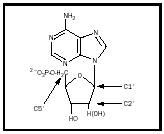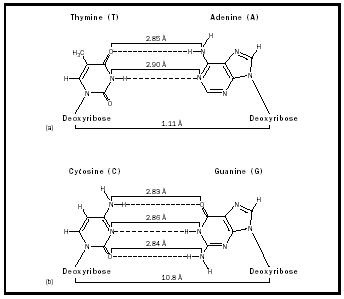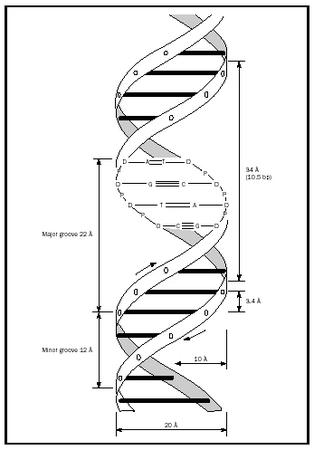Nucleic Acids

Nucleic acids are a family of macromolecules that includes deoxyribonucleic acid ( DNA ) and multiple forms of ribonucleic acid ( RNA ). DNA, in humans and most organisms, is the genetic material and represents a collection of instructions (genes) for making the organism. This collection of instructions is called the genome of the organism. The primary classes of RNA molecules either provide information that is used to convert the genetic information in DNA into functional proteins, or are important players in the translational process , in which the actual process of protein synthesis (on ribosomes ) occurs.
Discovery of and Evidence for DNA as the Genetic Material
DNA was first discovered in 1869 by a Swiss biochemist, Johann Friedrich Miescher. He extracted a gelatinous material that contained organic phosphorus from cells in human pus that was obtained from the bandages of wounded soldiers. He named this material nuclein. Ten years later Albrecht Kossel explored the chemistry of nuclein (for which he received the Nobel Prize) and discovered that it contained the organic bases adenine , thymine , guanine , and cytosine . In 1889 Richard Altman removed the proteins from the nuclein in yeast cells and named the deproteinized material nucleic acid. It was not until about 1910 that it was realized that there were two types of nucleic acid, DNA and RNA. A great deal of chemistry during the early part of the twentieth century focused on characterizing the composition of and the linkages in both DNA and RNA. A chemical test for deoxyribose, developed by Robert Feulgen during the 1920s, was the first test capable of distinguishing DNA from RNA. Because of the simplicity of the composition of DNA, which has only four bases (and early reports indicated erroneously that there were equimolar quantities of each), it was originally thought that DNA molecules functioned in chromosomal stability and maintenance. It was only after Erwin Chargaff, in 1950, showed that the molar amounts of the bases varied widely in different organisms that the notion that DNA might be the genetic material became an attractive idea.
The general consensus prior to the mid-1940s was that proteins (which contain twenty different amino acids) were the most logical candidate for the genetic material. Three later, however, findings pointed toward the conclusion that DNA was the genetic material. During the 1920s Frederick Griffith examined the activity of cell extracts in an attempt to identify a "transforming principle" (and a specific molecule related to this principle) in experiments with the bacterium Streptococcus pneumoniae. Unfortunately, his experiments failed to identify a specific molecule. In 1944 Oswald Avery, Colin MacLeod, and Maclyn McCarty partially purified cell extracts and presented evidence that the genetic component of these cells was DNA. In 1952 Alfred Hershey and Martha Chase investigated the infection of Escherichia coli cells with phage T2 (a virus) and their results were further corroboration that DNA was the genetic material. Since that time, a large body of evidence has confirmed the (nearly) universal truth that DNA is the genetic, heritable material in organisms. (The only exception to this is the case of RNA viruses, such as the AIDS virus, in which RNA is the only nucleic acid present in the virus and the genetic material.)
Modern research took a giant step forward when James Watson and Francis Crick, analyzing the collected findings of a number of laboratories, proposed the double helix structure of DNA in 1953. Their announcements motivated scientists to find corroboration for this proposal. During the 1980s detailed x-ray crystallographic analyses of DNA became acknowledged as proof of the structural arrangement that had been described by Watson and Crick, including the Watson–Crick complementary base-pairing arrangements. The elucidation of the structure of DNA led to an enormous and rapid expansion of our understanding of DNA's function in the living cell.
Types of Nucleic Acids: Composition and Structure
All nucleic acids are linear, nonbranching polymers of nucleotides, and are therefore polynucleotides. DNA is double-stranded in virtually all organisms. (It is single-stranded in some viruses.) DNA occurs in many, but not all, small organisms as double-stranded and circular (without any ends). Higher organisms (eukaryotes) have approximately ten million base pairs or more, with the genetic material parceled out into multiple genetic pieces called chromosomes. For example, humans have twenty-three pairs of chromosomes in the nucleus of each somatic cell . Within the nucleus, the DNA molecules are found in "looped arrangements" that mimic the circular DNA observed in many prokaryotes.
All RNA molecules are single-stranded molecules. RNA molecules are synthesized from DNA templates in a process known as transcription ; these molecules have a number of vital roles within cells. It is convenient to divide RNA molecules into the three functional classes, all of which function in the cytoplasm.
Messenger RNA (mRNA) contains the information (formerly residing in DNA) that is decoded in a way that enables the manufacture of a protein, and migrates from the nucleus to ribosomes in the cytoplasm (where proteins are assembled). A triplet of nucleotides within an RNA molecule (called a codon) specifies the amino acid to be incorporated into a specific site in the protein being assembled. A cell's population of mRNA molecules is very diverse, as these molecules are responsible for the synthesis of the many different proteins found in the cell. However, mRNA makes up only 5 percent of total cellular RNA.
Ribosomal RNA (rRNA) is the most abundant intracellular RNA, making up 80 percent of total RNA. The eukaryotic ribonucleoprotein particle (ribosome) is composed of many proteins and four rRNA molecules (which are classified according to size). Ribosomes reside in the cytoplasm and are the "molecular platform" (the actual physical site of) for protein synthesis.
Transfer RNA (tRNA) molecules contain between seventy-four and ninety-five nucleotides and all tRNAs have similar overall structures. There are twenty individual tRNAs; each one binds to a specific amino acid in the cytoplasm and brings its "activated amino acid" to a ribosome—part of the translational machinery that carries out protein synthesis. Transfer RNA makes up the remaining 15 percent of cellular RNA.

All nucleic acids are polynucleotides, with each nucleotide being made up of a base, a sugar unit, and a phosphate. The composition of DNA differs from that of RNA in two major ways (see Figure 1). Whereas DNA contains the bases guanine (G), cytosine (C), adenine (A), and thymine (T), RNA contains G, C, and A, but it contains uracil (U) in place of thymine. Both DNA and RNA contain a five-membered cyclic sugar (a pentose). RNA contains a ribose sugar. The sugar in DNA, however, is 2′-deoxyribose.
In DNA, each base is linked by a β -glycosidic bond to the C1′ position of the 2′-deoxyribose, and each phosphate is linked to either the C3′ or C5′ position. The linkages are essentially the same in RNA.
DNA is a right-handed, double-stranded helix, in which the bases essentially occupy the interior of the helix, whereas the phosphodi ester backbone (sugar-phosphate backbone) more or less comprises the exterior. The bases on the individual strands form intermolecular hydrogen bonds with each other (the complementary Watson–Crick base pairs). An adenine base on one strand interacts specifically with a thymine base on the other, forming two hydrogen bonds and an A–T base pair; while a G–C base pair contains three hydrogen bonds. These interactions possess a specificity that is pivotal to both DNA replication and transcription (see Figure 2).
DNA structure is also described in terms of primary, secondary, and tertiary structures. The primary structure is simply the sequence of nucleotides. The secondary structure refers to the hydrogen bonding between A–T and G–C base pairs. The tertiary structure refers to the larger twists and turns of the DNA molecule. Other features of DNA are the major and


minor grooves that run along the helix that are the target sites for DNA binding proteins involved in replication and transcription. Although DNA can exist in several alternate structures, the B-form of DNA (see Figure 3) is the biologically relevant form.
As stated previously, DNA is the genetic material in humans and in virtually all organisms, including viruses—with the exception of a few viruses that possess RNA as the genetic material.
In complex multicellular organisms (such as humans), DNA carries within itself the instructions for the synthesis and assembly of virtually all the components of the cell and (therefore) for the structure and function of tissues and organs. Within the approximately 3.2 × 10 9 base pairs (3.2 Gbps) in human DNA, the Human Genome Project has determined that there are a minimum of about 25,000 individual segments that correspond to individual genes. The genes collectively make up only about 2 to 3 percent of the total DNA, but encode the detailed genetic instructions for the synthesis of proteins. Proteins are the "workhorses" of the cell, and in one way or another are responsible for the functions that permit a cell to communicate with other cells and that define the character of the individual cell. A kidney cell is very different from a heart or eye cell. Although every cell contains the same DNA, different subsets of the 25,000 genes are expressed in the different organs or tissues. The expressed genes determine the type of cell that is produced and a cell's ultimate function in a multicellular organism.
Interestingly, there is only approximately a 0.1 percent difference in DNA among humans. The nucleotide sequences of DNA differs between organisms and is a fundamental difference between individuals and between species. For example, our closest (species) relative, the chimpanzee, has DNA that is 98.5 percent identical to that of humans.
SEE ALSO Deoxyribonucleic acid ; Double Helix ; Watson, Francis Dewey .
William M. Scovell
Bibliography
Berg, Jeremy M.; Tymoczko, John L.; and Stryer, Lubert (2002). Biochemistry, 5th edition. New York: W. H. Freeman.
Kimball, John W. (1994). Biology, 6th edition. Dubuque, IA: Wm. C. Brown Publishers. Also available from http://users.rcn.com/jkimball.ma.ultranet/BiologyPages/ .
Thank you very much☺😄😊